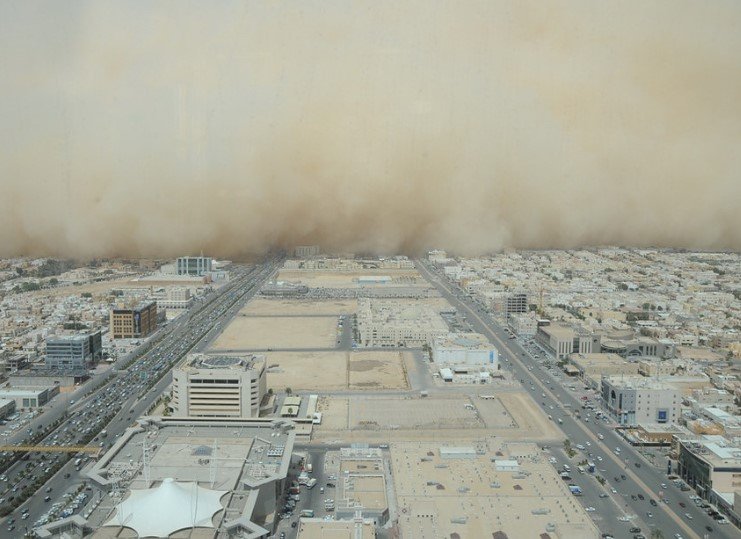Riyadh, Eastern Region brace for punishing winds and visibility drops as health officials warn vulnerable groups to stay indoors
Saudi Arabia is in for a punishing stretch of weather this week, with thick dust storms and scorching temperatures set to batter several regions through the weekend, according to forecasters. The warnings come as parts of the Kingdom continue grappling with some of the hottest days of the summer so far.
The National Center for Meteorology (NCM) on Tuesday issued a wide-ranging advisory covering cities across the north, west, and center of the country. Winds whipping up dense clouds of dust are expected to cause reduced visibility across major highways and urban centers—including Riyadh, which has already been blanketed in a yellow haze since early morning.
Heat and haze spread across the capital and beyond
Residents in Riyadh have reported gritty air and stinging eyes, as dust settled heavily across the city’s roads, rooftops, and windows. For some, it’s been hard to tell if it’s morning or late afternoon—the sunlight has turned a dull gold.
In its daily bulletin, the NCM warned that maximum temperatures in the capital are hovering around 42°C, while nighttime lows will only drop to 30°C, providing little relief.
It’s not just the capital feeling the heat and haze.
From the Eastern Region to Al-Jouf, and as far south as Najran, winds carrying fine desert particles are expected to sweep through with gusts as high as 50 kilometers per hour.

“This is typical summer weather for central Arabia,” said Dr. Majed Al-Mutairi, a climate scientist based in Jeddah. “But what we’re seeing now is prolonged exposure to high heat paired with high wind events, which is more taxing on public health and infrastructure.”
Rural governorates on alert for localized dust storms
While big cities like Riyadh and Dammam have dominated headlines, it’s the surrounding rural areas that are arguably more vulnerable.
The NCM issued targeted alerts for several smaller governorates on Tuesday, warning of late afternoon storms that could kick up blinding dust and push small debris into roads. These include:
-
Al-Kharj
-
Al-Hariq
-
Al-Muzahmiyya
-
Al-Dalam
-
Hawtah Bani Tamim
-
Diriyah
Al-Sulayyil and Wadi Al-Dawasir, both in the southern Riyadh Province, were specifically flagged for more intense wind episodes later in the day, while Al-Aflaj was placed under all-day watch.
For locals in these towns, the warnings are more than a formality. “When the dust blows in, you can’t see the car in front of you,” said Saleh bin Khaled, a shopkeeper in Al-Aflaj. “It’s like walking through smoke, but it scratches your throat.”
Maritime zones face stormy seas and shifting winds
It’s not just land that’s taking the brunt. Offshore winds are also building up, stirring concern over maritime navigation in both the Red Sea and the Arabian Gulf.
According to NCM data, wind speeds are projected to reach up to 50 kph in the southern Red Sea waters. Conditions in the northern Arabian Gulf aren’t looking much calmer either, with gusts up to 45 kph expected in the coming days.
The following table outlines the latest maritime wind projections:
| Sea Region | Wind Speed (kph) | Direction | Notes |
|---|---|---|---|
| Red Sea (North/Central) | 10–28 | Variable | Stable to mild conditions |
| Red Sea (South) | Up to 50 | Northerly | Choppy; advisories for small craft |
| Arabian Gulf (North) | Up to 45 | Northwesterly | Rough waters; cargo delays likely |
| Arabian Gulf (South) | 15–25 | Moderate | No alerts issued |
Some shipping routes have already started adjusting their timelines. Two commercial cargo lines operating between Dammam and Bahrain confirmed delays due to expected wind surges midweek.
Health ministry urges caution as dust thickens
The Saudi Ministry of Health issued a public advisory late Tuesday, urging residents to stay indoors unless absolutely necessary. Respiratory clinics across the Kingdom were placed on high alert.
In particular, those with asthma or chronic respiratory issues have been asked to avoid outdoor exposure.
Dr. Maha Al-Shehri, a pulmonary specialist at King Fahad Medical City, said emergency rooms often see a 15% spike in respiratory cases during peak dust events. “We’re already seeing more patients coming in with coughing, shortness of breath, and even eye inflammation,” she added.
Schools have not yet been closed, but several private institutions in Riyadh gave parents the option of remote learning for the remainder of the week.
Businesses and travel services brace for disruptions
For businesses dependent on outdoor operations—construction firms, logistics handlers, and roadside vendors—the storms present logistical headaches and health hazards.
One delivery app in Riyadh reported a 23% drop in same-day orders between Monday and Tuesday, due to both heat fatigue among drivers and visibility concerns in traffic.
Meanwhile, travel agencies are keeping close tabs on the evolving forecast. While commercial flights are currently operating on schedule, visibility below 1 kilometer could trigger cascading delays at hubs like King Khalid International Airport.
The national railway operator SAR issued a statement Tuesday evening advising passengers to check for real-time updates, especially for trains running through exposed desert corridors.
No quick relief in sight, says forecast
If you’re waiting for cooler air to roll in—don’t hold your breath.
According to the NCM’s extended forecast, the heatwave is expected to persist into the early part of next week, with little to no rainfall expected across affected areas.
Nighttime temperatures might drop slightly, but daytime highs will stay above 40°C in most inland regions.
“It’s a hard stretch,” said Khalid Al-Ahmari, a roadside tea seller near Riyadh’s Al Batha district. “You sell less, you sweat more—and there’s no wind that cools, only the wind that burns your eyes.”
